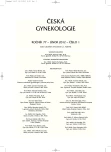Does the asymptomatic carriage of FV Leiden and FII prothrombin in heterozygous configuration represent the inccreased risk of thrombembolic complications during pregnancy, childbirth and postpartum?
Authors:
T. Binder 1; B. Vavřinková 1; I. Hadačová 2; I. Hrachovinová 3; P. Salaj 3; Martin Hruda 1
Authors‘ workplace:
Gynekologicko-porodnická klinika 2. LF UK a FN Motol, Praha, přednosta prof. MUDr. L. Rob, CSc.
1; Hematologické odd. FN Motol, Praha, primářka MUDr. I. Hochová
2; ÚHKT Praha, přednosta prof. MUDr. M. Trněný, CSc.
3
Published in:
Ceska Gynekol 2012; 77(1): 25-30
Category:
Original Article
Overview
Objective:
To evaluate the course of pregnancy and puerperium in asymptomatic carriers of FV Leiden and FII prothrombin mutation in heterozygous configuration in terms of risk of thrombembolic disease and late pregnancy complications. To evaluate whether global prophylactic LMWH administration already during pregnancy has brought some benefit to these women.
Type of study:
Prospective study.
Methods:
From June 2007 to June 2011, we monitored the incidence of thrombembolic events (TED) and severe late pregnancy complications in 473 asymptomatic carriers of FV Leiden and FII prothrombin mutation in heterozygous configuration. We also compared the ongoing changes of commonly clinically available hemocoagulation tests. In selected women, we added to coagulation tests a thrombin generation test (TGA) and thrombin-antithrombin test (TAT). In 253 women (Group A), preventive LMWH application was introduced already during pregnancy. In 220 women (Group B), the application of LMWH was commenced as late as on the delivery day. In both groups application of LMWH continued during the puerperium. ¨
Results:
The incidence of TED in the whole group of carriers of thrombophylic mutations accounted for 0.19%. The incidence of severe late pregnancy complications was very low – 3%. Medians of the monitored parameters of the hemocoagulation in compared groups and ‘healthy’ controls did not show statistically significant differences at any stage of pregnancy, labor or end of puerperium, with the exception of the results of TAT test at the end of puerperium.
Conclusions:
No direct causal relationship has been established between asymptomatic carriage of Leiden and prothrombin mutation in heterozygous configuration and the occurrence of severe late pregnancy complications. These types of mutation represent only a slightly increased risk in terms of development of thrombophylic events. General LMWH prophylaxis during pregnancy is not indicated. However, individual careful monitoring of hemocoagulation changes and early detection of associated transient situations potentiating risk of thrombembolic events is desirable. Statistically significant differences in the TAT results between group A and B at the end of puerperium revealed that the recommended extended LMWH prophylaxis until the end of puerperium was not followed by a number of women who started the prophylaxis on the date of labor.
Key words:
pregnancy, asymptomatic carriage of Leiden and prothrombin mutation in heterozygous configuration, late pregnancy complications, coagulation changes.
Sources
1. Bates, SM., Greer, IA., Hirsh, J., Gingsberg, JS. Use of antithrombotic agents during pregnancy. Chest, 2004, 126 (3 Suppl.), p. 627S-644S.
2. Martinelli, I., Battaglioli, T., De Stefano, V., et al. The risk of first venousus thrombembolism during pregnancy and puerperium in double heterozygotes for factor V Leiden and prothrombin G20210A. J Thromb Haemost, 2008, 6(3), p. 494-498.
3. Samama, MM., Rached, RA., Conard, J., et al. Pregnancy – associated venous thrombosis in women with hereditary heterozygous factor Leiden and /or factor II gene mutations. Bull Acad Natl Med, 2004, 188(8), p. 1377-1393.
4. Rodger, MA., Carrier, M., Keely, E., et al. The management of thrombophilia during pregnancy: a Canadian survey. J Obstet Gynaecol Can, 2002, 24(12), p. 946-952.
5. Middeldorp, S., Meinardi, JR., Koopman, MM., et al. A prospective study of asymptomatic carriers of the factor V Leiden mutation to dermine the incidence of venous thrombembolism. Ann Intern Med, 2001, 135(5), p. 322-327.
6. Papaian, LP., Kobilianskaia, VA., Sheldina, AM., et al. Changes in hemostasis system in patients with hereditary thrombophilia caused by mutation of blood coagulation factor V (factor V Leiden). Ter Arkh, 2001, 73(7), p. 47-51.
7. Greer, IA. Prevention and management of venous thrombembolism in pregnancy. Clin Chest Med, 2003, 24, p. 123‑137.
8. O’Connor, DJ., Scher, LA., Gargiulo, NJ., et al. Incidence and characteristics of venous thrombembolic disease during pregnancy and the postnatal period: a contemporary series. Ann Vasc Surg, 2011, 25(1), p. 9-14.
9. Bates, SM., Greer, IA., Pubinger, I., et al. Venous thrombembolism, thrombophilia, antithormbotic therapy and Pregnancy. Chest, 2008, 133, 6, suppl. P. 844S-886S.
10. Geerts, WH., Berquist, D., Pineo, GF., et al. Prevention of venous thrombembolism: American Chest Physicians Evidence – Based Clinical Practice Guidelines (8th Edition) Chest, 2008, 133, 6 ,suppl. p. 381S-453S.
11. Roger, MA. Anticoagulant prophylaxis for placenta mediated pregnancy complications. Thromb Res, 2011, 127, suppl. 3, p. S76-S80.
12. Castoldi, E., Rosing, J. Thrombin generation tests. Thromb Res, 2011, 127, Suppl. 3, p. S21-S25.
Labels
Paediatric gynaecology Gynaecology and obstetrics Reproduction medicineArticle was published in
Czech Gynaecology

2012 Issue 1
Most read in this issue
- Is the hysteroscopy the right choice for therapy of placental remnants?
- To conclude knowledge about new colposcopic signs – ridge sign and inner border.
- Risk factors for recurrent disease in borderline ovarian tumors
- The psychosocial needs of newborn children in the context of perinatal care
